Abstract
Carbonatite complexes and associated fenite zones are famous for their high-grade rare metal ores. The carbonatite–fenite complexes generally contain high concentrations of light rare earth elements (LREE), thorium (Th), and uranium (U). While most carbonatites are closely related to continental rift zones, some complexes can be observed in post-collisional tectonic environments. The Özvatan nepheline syenite–carbonatite complex is an example of post-collisional carbonatitic magmatism in Central Anatolia, Turkey. The magmatic suite is generally composed of silica-undersaturated ultra-alkaline rocks and carbonatite dikes accompanied by high-intensity fenite zones. The carbonatites of the complex are generally dominated by coarse-grained calcite minerals accompanied by fluorite phenocrysts and may also contain minor amounts of rock-forming silicate minerals. The metasomatic aureole zones (fenites) are mainly composed of euhedral nephelines, K-feldspars, aegirines, augites, and garnets. Carbonatites of the Özvatan complex show enrichments in Ca and F with depletion of alkaline (K and Na) elements. Carbonatites and fenite zones of the Özvatan complex host a variety of incompatible elements, including La, Ce, Nd, Th, U, and Nb. The isotopic composition and general geochemical properties of carbonatites in the study area represent mantle-derived carbonatites rather than crustal limestones/skarns.
1. Introduction
Lanthanides, commonly referred to as rare earth elements (REE) are a total of 15 elements and have distinct physical and chemical properties. These elements are considered to be critical raw materials due to the increasing demand for information technologies, hybrid vehicles, and renewable energy production. The main light rare earth elements (La–Eu; LREE) sources of the world are carbonatite–alkaline complexes, for at least four decades. These complexes generally have significant enrichments in terms of niobium (Nb), uranium (U), thorium (Th), iron (Fe) as well as REE [1,2]. The carbonatite–alkaline complexes are generally emplaced during an extensional tectonic regime which formed in an over-thickened crust after a collisional subduction process [3,4,5]. However, some carbonatite intrusions can be observed in post-collisional tectonic settings [6,7,8,9,10]. Three main hypotheses about the origin of carbonatitic magma were widely accepted by the scientific community in recent years: (1) the carbonatitic phases may be derived from primary mantle melts [11,12,13] or from (2) the liquid immiscibility of carbonated silicate rocks [14,15]. (3) The extreme magmatic fractionation of a carbonated silicate melt concept is also gaining support among various researchers [16,17,18]. The mineralization, concentration, and distribution of the REE in carbonatite–alkaline complexes are generally controlled by both magmatic and post-magmatic events including intense alkaline metasomatism of country rocks which are often referred to as fenitization [2,19]. The REE mineralization in carbonatite complexes can be restricted into two main groups; the primary carbonatite bodies may host significant amounts of primary REE-bearing magmatic minerals [20,21,22]. The metasomatic activities of magmatic or late-stage fluids originating from carbonatite residue also have a major role in REE mineralization [2,23]. In Turkey, the vast majority of published data on alkaline complexes were primarily focused on Eskişehir–Kızılcaören [1,9,24,25,26,27] and Malatya–Kuluncak [9,28,29] deposits. Despite most of the carbonatites being closely associated with alkaline intrusive complexes (ijolites, phoscorites, and nepheline syenites), Kızılcaören deposit is unique with the earlier volcanic and subvolcanic rocks (trachytes and phonolites), carbonatite–silicate dike-like bodies and fluorite–barite–bastnasite-bearing brecciated fenite zones [24,26,27]. The Kızılcaören LREE–Th–fluorite–barite deposit is a product of an alkaline tearing-rifting mechanism that was active in the Eocene–Late Miocene period [30]. On the other hand, a few numbers of potassic–alkaline volcanic-related LREE enrichments (fly ash placers and ignimbritic flow deposits) were also detected in the Isparta region of SW Turkey, which is located on the southern part of the same Eocene–Late Miocene tearing zone [31].
The two alkaline intrusion-related REE deposits, Malatya–Kuluncak and Sivas–Karaçayır are located on the East of the Central Anatolian Crystalline Complex (CACC) and are closely related to Late Cretaceous post-collisional magmatism [32,33]. This widespread magmatism in Central Anatolia produced numerous calc–alkaline and alkaline granitoid emplacements [29,34]. Most of these post-collisional granitoids are S- and I-type granites [34,35]; however, some alkaline granitoids can also be observed in the region [32].
The alkaline ultrapotassic rock suites are generally syenites and foid syenites emplaced into highly metamorphosed continental crust [36]. Most of the scientific data available on the carbonatite complexes in eastern CACC are restricted to the petrogenetic and isotopic features of these intrusions [9,33,37]. However, the scientific literature about geochemical properties of fenitized rocks in the carbonatite–nepheline syenite complexes of Central Anatolia is not very detailed. Özvatan complex is one of the REE-bearing nepheline syenite–carbonatite intrusions in Central Anatolia. The prior studies in Özvatan complex were restricted to petrological properties [38] and mica geochemistry [39] of nepheline syenites. In this study, we focused on the alkaline rock suites of Özvatan carbonatite–nepheline syenite complex and the mineralization properties of fenite zones. Additionally, the metasomatic transformation of carbonatites has been revealed with fluid inclusion studies. This nepheline syenite–carbonatite complex with high-intensity fenitization zones is expected to host considerable concentrations of incompatible elements in terms of both REE and LILE.
2. Geological Setting
The study area is located in the Eastern part of the Central Anatolian Crystalline Complex (CACC) (Figure 1a,b). The CACC is made up of several metamorphic sequences and magmatic rocks emplaced into those metamorphic rocks. The Akdağ Massif [40,41], Kırşehir Massif [41,42,43,44], Aksaray Massif [41], and Niğde Massif [45,46] are jointly forming the CACC. These metamorphic rock sequences were intruded by several post-collisional plutonic rocks with calc-alkaline and alkaline nature [34,47,48]. The peraluminous S-type granitoids are generally located in the northern parts of the CACC [49]. However, some S-type granitoid intrusions were identified in southwestern parts of the Kırşehir Massif [47,50]. These S-type granitoids of the CACC show enrichments of incompatible elements including LILE and LREE [50].
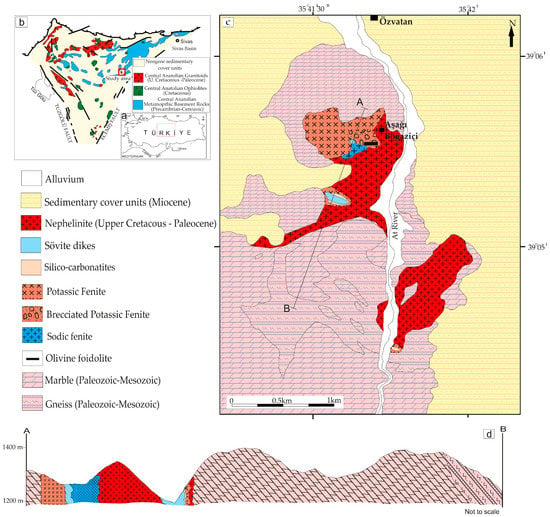
Figure 1.
(a) Location map of Central Anatolian Crystalline Complex (CACC), (b) simplified geology map of the CACC modified from Kadıoğlu et al. [36], (c) geological map of the study area modified from Kraeff and Pasquare [51], (d) geological cross-section of carbonatites and fenitized nepheline syenites in Özvatan complex.
Further, some of these granites host considerable amounts of U [52,53]. Therefore, Cenozoic cover sediments can be considered valid exploration targets for sandstone-hosted uranium deposits [53]. On the contrary, more common post-collisional I-type magmatism can be observed in various locations in CACC [35,50,54,55]. Mainly, I-type granitoids of CACC have metaluminous to a slight peraluminous character with high K concentrations, indicating mantle interference during magma evolution [35]. These granitoids mostly share similar geochemical and isotopic features such as LREE enrichments and lower initial Sr isotopes [35].
Widespread potassic magmatism occurred after the calc-alkaline granitoid emplacement, with the intrusions of syenite and monzonite bodies along the formation of alkaline complexes such as Kuluncak [28,29,37] and syenite–carbonatite complex Karaçayır [33,37,56].
The Özvatan nepheline syenite–carbonatite complex emplaced into Paleozoic-aged highly metamorphosed carbonate rocks known as Akdağ Massif (Figure 1c and Figure 2a,b) [40,46,57,58]. Akdağ massif rocks in the study area mainly consist of meta-carbonate and meta-clastic rocks such as marbles, calc-schists, quartzites, mica schists, phyllites, and gneisses (Figure 2a,b) [57]. Moreover, contacts of the nepheline syenites and meta-carbonate rocks host weak skarnization zones with epidote crystals (Figure 2c,d). The magmatic complex can be described as a silica-undersaturated nepheline syenite intrusion (Figure 2e) [36,38,39,51]. The nepheline syenites were cut by medium- to coarse-grained calciocarbonatite dikes (sövites) and silicocarbonatites (Figure 2f,g). All rocks in Özvatan nepheline syenite–carbonatite complex are affected by hydrothermal alteration mostly caused by activities of fenitizing fluid pulses around carbonatites (Figure 2g–k). The silicate rocks of the complex are mainly fenitised nepheline syenites and garnet-bearing nepheline syenites; however, some dike-like olivine foidolite bodies surrounded by nepheline syenites were also observed [51]. The olivine foidolites host thin carbonatite veinlets and small nepheline syenite pockets. Therefore, they represent an older magmatic phase than the rest of the complex (Figure 2l).
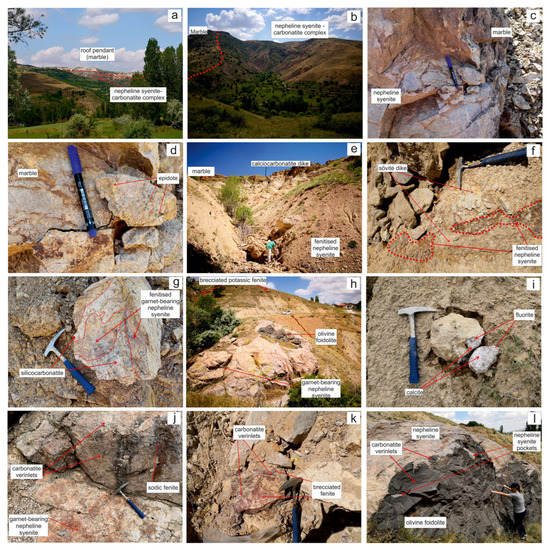
Figure 2.
(a,b) General view of nepheline syenites and marbles; (c) nepheline syenites and marble contact; (d) epidote minerals in nepheline syenite–marble contact; (e,f) calciocarbonatite dikes and fenitised nepheline syenites of the complex; (g) silico-carbonatite veins and fenitised garnet-bearing nepheline syenites; (h) general view of garnet-bearing nepheline syenites, olivine foidolite, and brecciated potassic fenites; (i) florite-bearing calciocarbonatite; (j) garnet-bearing nepheline syenite, carbonatite veinlets, and sodic fenite; (k) carbonatite veinlets and brecciated potassic fenite; (l) nepheline syenites, olivine foidolite, and carbonatite veinlets.
3. Sampling and Analytical Methods
A total of 23 samples were collected from carbonatite dikes and fenitized zones of the Özvatan nepheline syenite–carbonatite complex. The whole-rock (major-trace and rare earth elements) analyses were conducted on powders obtained by using an agate mortar muller milling device. The major oxides (SiO2, Al2O3, CaO, K2O, Na2O, Fe2O3, MnO, MgO, TiO2, and P2O5) were analyzed using a Bruker S8 Tiger X-ray fluorescence (XRF) spectrometer with wavelength ranges from 0.01 to 12 nm, the analytical uncertainty is usually 5%. REE analyses were conducted by an Elan DRC-e Perkin Elmer Inductively Coupled Plasma-Mass Spectrometry (ICP-MS). A two-step digestion process was used with 50 mg powdered samples: (1) 6 mL of 37% HCl, 2 mL of 65% HNO3, and 1 mL of 38–40% HF acid mixer put in a pressure- and temperature-controlled Teflon beaker using a Berghoff Microwave at 135 °C; (2) 6 mL of 5% boric acid solution was added to the step one mixer for ICP-MS analyses. All geochemical analyses were performed in Istanbul Technical University Geochemical Analysis Laboratories (ITU-JAL).
The C and O isotope values are obtained from calcite separates by using a ThermoFinnigan Deltaplus XP mass spectrometer and gas chamber in the Stable Isotope Ratio Mass Spectrometry Laboratory of Middle East Technical University (METU-DIL). The typical uncertainty level is 18O/16O: ± 0.2 (‰) and 13C/12C: ± 0.2 (‰). The electron microprobe analyses (EPMA) were conducted on double-polished sections and grain mounts. The grain mounts and polished sections were analyzed by JEOL 8900R in the University of Alberta Electron Microprobe Laboratory. The operating conditions of this instrument: 20 kV for accelerating voltage and 10 nA beam current.
The rock-forming minerals were determined using Leica DM750P microscope and cathodoluminescence images were produced by CTIL MK5 microscope. Fluid inclusion investigations were performed on ~80 µm thick doubly-polished thin sections of calcite and fluorite minerals in the fluid inclusions labs at the Geological Engineering Department of Istanbul Technical University (ITU). A heating–freezing Linkam THMG-600 stage was used to take measurements (temperatures from +600 to −200 °C) and was mounted on a LEICA DM2500P optical microscope with a video camera and monitor. Potassium dichromate, pure H2O, CO2, and H2O-NaCl standards were used to calibrate this stage. Using the standard methods outlined by Roedder [59] and Shephard et al. [60], microthermometric measurements of heating and freezing were conducted with an error of ±0.4 °C for the freezing stage and ±5.0 °C for the heating stage. The values of homogenization temperature (Th), eutectic temperature (Te), last-ice melting temperature (Tm-ice), and clathrate melting temperature (Tm-clt) were all monitored throughout these measurements.
4. Results
4.1. Petrography
4.1.1. Nepheline Syenite, Fenitised Nepheline Syenite, and Olivine Foidolites
The nepheline syenites of the Özvatan complex are mainly composed of nepheline and K-feldspars having microperthite texture accompanied by minor amounts of albite, phlogopite, and sericite minerals (Figure 3a–d). The holocrystalline, coarse-grained, fenitised nepheline syenites can be distinguished in sodic and potassic on the basis of their mineralogy. The sodic fenitization is interested mainly in the garnet-bearing nepheline syenites composed of nepheline, K-feldspar, clinopyroxene, garnet, biotite, and sericite crosscut by carbonatite veinlets (Figure 3e–l). This rock type shows coronitic texture with fine-grained intergrowth of aegirine crystals around large euhedral augite crystals. Smaller augites might be completely replaced by aegirine (Figure 3j). K-feldspars mainly occurred around carbonatite veins and crystallized along the mafic (garnet-rich) nepheline syenite contact. The garnets are generally euhedral crystals with a light brown color and are classified as andradite by Ozkan and Erkan [38]. The K-feldspars seem more likely to form comb textures: crystals growing orthogonally from a cold contact typically found in dikes. It implies that they are growing from the carbonatite melt (Figure 3i,l) [19]. The clinopyroxene group minerals are mainly augites and aegirine minerals in which the augite was partly to completely transformed to aegirine indicating sodic fenitization (Figure 3j,k). The potassic fenites have abundant K-feldspars, nephelines, and minor amounts of aegirine crystals (Figure 3m–p). The sericitization of K-feldspars on crystal borders is also common due to late-stage hydrothermal activity or atmospheric weathering (Figure 3l,p). Additionally, the giant phlogopite crystals in nepheline syenites were reported by Deniz [39]. The olivine foidolites are predominantly composed of highly altered olivine, clinopyroxene, and subordinate nepheline phenocrysts. The phenocrysts are generally embedded in a medium-grained microcrystalline groundmass of plagioclase, orthoclase, phlogopite, and calcite with minor amounts of opaque minerals (Figure 3p,q). The olivine phenocrysts were altered to talc minerals due to extensive hydrothermal alterations (Figure 3s).
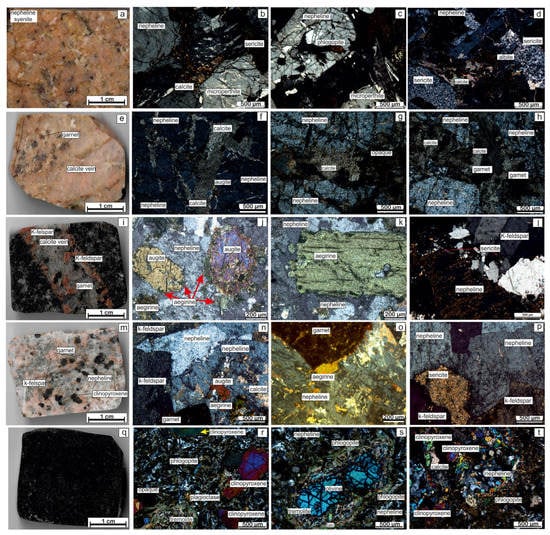
Figure 3.
(a–d) Nepheline, microperthite, and phlogopite-bearing nepheline syenite; (e–h) the carbonatite vein and fenitized garnet-bearing nepheline syenite; (i) fenitization around the carbonatite veinlet; (j) partial transformation of augite to aegirine in fenitized nepheline syenite; (k) complete transformation of augite to aegirine in fenitized garnet-bearing nepheline syenite; (l) sericitization and K-feldspar growth around nepheline phenocrystal; (m–p) garnet-bearing potassic fenite in nepheline syenit; (m–p) olivine, clinopyroxene, and nepheline in olivine foidolite (q–t).
Based on the observations from fieldwork, the olivine foidolites cannot be described as a usual ultrapotassic sub-volcanic type rock which is common in alkaline–ultra-alkaline complexes [4].
4.1.2. Calciocarbonatites and Silicocarbonatites
The carbonatitic rocks in Özvatan complex are generally well-crystallized coarse-grained calciocarbonatites (sövites) and fine-grained silicocarbonatites which are emplaced into garnet-bearing nepheline syenites (Figure 4a–d,m–p). The calciocarbonatites are generally dominated by calcite and fluorite, with minor amounts of fine-grained nepheline and opaque minerals (Figure 4e–l). The silicocarbonatites are generally fine- to medium-grained and brownish to pinkish in color (Figure 4m). They are mainly composed of calcite, nepheline, and garnet with a subordinate amount of sericite and opaque minerals (Figure 4n–p).

Figure 4.
(a–d) the silicocarbonatite veinlets and garnet-bearing nepheline syenites; (e–h) fluorite bearing carbonatite; (i–l) coarse-grained calcite carbonatites (sövites) (m–p); fenitized nepheline syenites with carbonatite veinlets.
The presence of subhedral grains of nephelines in sövites was emplaced into the earlier nepheline syenite phases (Figure 4j). The different stages of carbonatite emplacements can be observed in cathodoluminescence (CL) images (Figure 5).
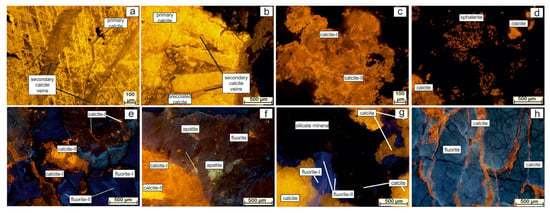
Figure 5.
(a–c) CL images of fluorite-bearing carbonatites; (d) CL image of sphalerite and carbonatite; (e–h) CL images of multi-stage carbonatite fluorite-bearing carbonatites.
The multiple phases of carbonatite emplacements in nepheline syenites (Figure 5c,g) and carbonatite breccia were identified (Figure 5a,b). Minor amounts of sulfide minerals can also be found (Figure 5d). The carbonatite phases were crosscut by late carbonatite and fluorite veins (Figure 5f,g). Fluorites can contain minor amounts of apatite phenocrystals. (Figure 5f). All generations of fluorites were replaced with late-stage carbonatite veinlets along the cracks and borders (Figure 5h).
4.1.3. Electron Microprobe Analysis (EPMA) of Carbonate, Fluorite, and Fenite Mica Minerals
The EPMA data of the carbonate minerals reveal that these carbonate minerals have higher amounts of CaCO3 (94.39–98.49) with minor amounts of MgCO3 (an average of 0.9), MnCO3 (an average of 1.04), FeCO3 (an average of 1.38), and SrCO3 (an average of 0.33) (Supplementary Table S1) and are classified as pure calcites, while the EPMA data of the fluorite minerals reveal that Ca and F contents vary from 52.07 to 53.03 wt.% and from 49.36 to 50.28 wt.%, respectively, with calculated near-stoichiometric compositions Ca0.99-1.00F1.99-2.00 (Supplementary Table S2). Minor contents of Mn (avg. 0.006 wt.%), Na (avg. 0.02 wt.%), and P (avg. 0.02 wt.%) are recorded in fluorite minerals.
The mica compositions of Özvatan rocks were previously studied in detail by Deniz [39]. In this study, the micas of K-fenite were examined to reveal the effects of metasomatic activities in K-fenite zones. The representative EPMA data of micas are listed in Supplementary Table S3. The recalculation of the mica minerals is based on Tindle and Webb [61].
The metasomatism process in K-fenites resulted in higher Al values in mica minerals. Therefore, the micas from K-fenites are biotites that show a slight annite trend (Figure 6). The giant mica minerals obtained from relatively unaltered nepheline syenites generally have higher Fe values [39]. Additionally, the effects of metasomatism can be observed in the rims of K-fenite micas with higher Fe values. In contrast, Mg and Si generally decrease from core to rim. It can be concluded that the fenitizing fluids affect the final compositions of micas in such a way that immobile cations arise. The majority of the analyzed micas are re-equilibrated (hydrothermal) biotites that evolve in equilibrium with the magmatic-hydrothermal fluids [62].
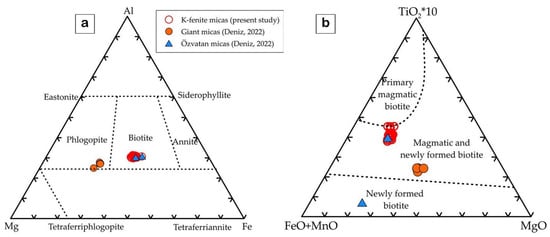
Figure 6.
(a) Compositional variation of mica in Özvatan fenites modified from Brod et al. [63]. The giant mica and nepheline syenite mica data taken from Deniz [39]. (b) (FeO + MnO)-MgO-TiO2 ternary diagram of biotite after Nachit et al. [64] and Nachit et al. [65].
4.2. Geochemistry
The representative geochemical analyses of major, trace, and REE are listed in Supplementary Table S4.
The nepheline syenites in the Özvatan complex are primarily silica under-saturated alkaline rocks (the least altered N-1 sample, Supplementary Table S4). The total alkali–silica diagram for least altered nepheline syenites may reflect the alkaline nature of the non-fenitised rocks (Figure 7). However, due to intense fenitization in the complex, the geochemical composition of the nepheline syenites cannot represent the initial values.
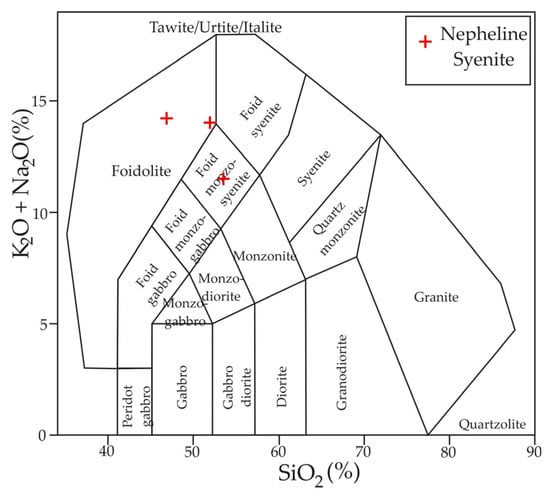
Figure 7.
Total alkal–silica (TAS) diagram for least altered nepheline syenite, modified from Middlemost [66].
The nepheline syenite–carbonatite complex shows a loss of alkalis during the formation of calciocarbonatite intrusions (Figure 8a). The carbonatites in the Özvatan complex can be divided into two distinct types: (a) calciocarbonatites (sövites) and (b) silicocarbonatites. Calciocarbonatites are mainly dominated by Ca and Sr as expected. Silio-carbonatites, on the other hand, are comprised of Si and Ca equally. Some silico–carbonatites have minor amounts of Al and Fe, probably related to the presence of silicate minerals.
The fenite zones can be classified as sodic, potassic, and brecciated potassic fenites due to their mineralogical and geochemical properties The sodic fenites in the Özvatan complex are closely related with silicocarbonatite rocks and their contact zones with garnet-bearing nepheline syenites. The sodic fenites are relatively less altered than potassic fenites and Na2O values can rise up to 6.63%. However, the sodic fenites were also overprinted by potassic fenites in some samples, decreasing the overall Na and Si content. The fenites of the complex predominantly have a potassic character (Figure 8b). The potassic fenites are characterized by high levels of K2O (varying from 8.13 to 15.7%) and relatively low levels of SiO2 content (Supplementary Table S4). The desilisification process during the transition of sodic fenite to potassic fenite may lead to an increase in Al contents [67].
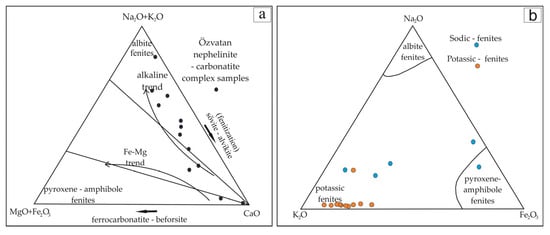
Figure 8.
(a) Carbonatite variation diagram modified after Le bas. [3]; (b) ternary plots for fenite types of Özvatan complex modified from Höy [68].
The calciocarbonatites, silicocarbonatites, and potassic fenites of the Özvatan complex show a negative linear SiO2 vs. CaO correlation with R2 = 0.98 (Figure 9a). This correlation of CaO and SiO2 shows silicocarbonatites are likely to be more associated with fenitization process. The sodic fenites do not share the same behavior. Similar geochemical trends can also be observed in Na2O + K2O + CaO vs. SiO2 + Al2O3 (Figure 9b) and SiO2 + Al2O3–CaO–Na2O + K2O (Figure 9c) indicating the effect of silicocarbonatites in progressive fenitization.
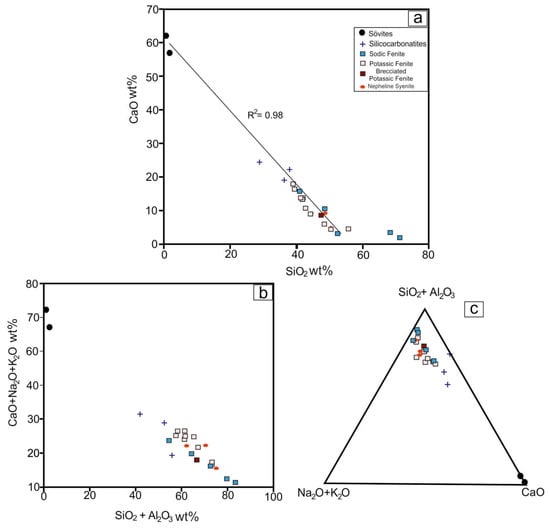
Figure 9.
(a) SiO2 and CaO major element variations of Özvatan nepheline syenite–carbonatite complex, after Rosatelli et al. [69]; (b) Na2O + K2O + CaO vs. SiO2 + Al2O3 diagram modified from Le Bas et al. [70]; (c) SiO2 + Al2O3–CaO–Na2O + K2O diagram of Özvatan nepheline syenite–carbonatite complex rocks after Rosatelli et al. [69].
REE concentrations of carbonatites in the Özvatan complex range from approximately 1000–2700 ppm. The calciocarbonatites and silicocarbonatites have similar average REE values, mostly comprising LREE (Supplementary Table S4). While calciocarbonatites (sövites), silicocarbonatites, and potassic fenites of the Özvatan complex have sharp pikes of LREE, the MREE and HREE patterns are generally flat (Figure 10). The calciocarbonatite (SD-1 sample) and brecciated potassic fenite (sample KF-7) have similar La and Ce concentrations to average calciocarbonatites; however, the rest of the REE pattern is much lower.
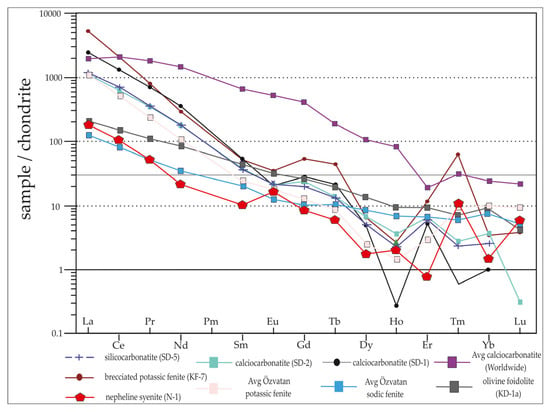
Figure 10.
REE patterns of nepheline syenite, carbonatites, and fenites in Özvatan complex modified from Boynton [71]. The worldwide average Ca-Carbonatite data is from Wolley [5].
The olivine foidolites and sodic fenites are relatively enriched in LREE and have relatively lower MREE and HREE patterns (Figure 10). However, the HREE values of olivine foidolite are higher than the entire rocks of the complex. Average sodic fenite has quite comparable values to least altered nepheline syenite in terms of LREE, but has elevated MREE and HREE patterns (Figure 10).
The elevated LREE, LILE, Nb, Th, and U values (Supplementary Table S4) were observed in K-fenites and brecciated K–fenite zones. The higher values of Nb, Th, U, and LREE (Figure 11) in brecciated K-fenites were observed. These results might be attributed to late-stage veins in which fenitization fluids utilized the brecciated part of the nepheline syenite intrusion, which had greater permeability after the formation of early sodic fenites and K-fenites [2,4,67]. K-Fenites also have higher Pb values than sodic fenites, indicating some sulfur-rich hydrothermal activity.

Figure 11.
Mantle normalized trace element patterns of carbonatites and fenites in Özvatan complex, after Sun and Mcdonough [72].
4.3. Isotopic Compositions of Özvatan Carbonatites
Özvatan carbonatites show significant fractional crystallization and hydrothermal alteration trends in terms of δ13C and δ18O isotopic compositions. As listed in Table 1, the δ13C values are quite compatible with the worldwide carbonatite range (+4 to −7) [73].

Table 1.
δ13C (PDB) and δ18O (SMOW) values of Özvatan carbonatites.
The δ13C values of Özvatan carbonatites and Karaçayır carbonatites have significant resemblance due to the evolution from a similar magmatic origin [37]. The δ11B values of Karaçayır from Cimen et al. [37] clearly indicate a magmatic origin of carbonatites. However, the effects of crustal contamination and hydrothermal alteration processes were also observable [37]. These processes may also affect Özvatan carbonatites in a similar way.
The δ18O values are also in tune with the Sivas–Karaçayır carbonatite nepheline syenite complex; however, the well-known Kızılcaören carbonatite complex reflects higher δ18O values (Figure 12). The high δ18O values of the Kızılcaören complex may have been caused by hydrothermal alteration [9,73,74].
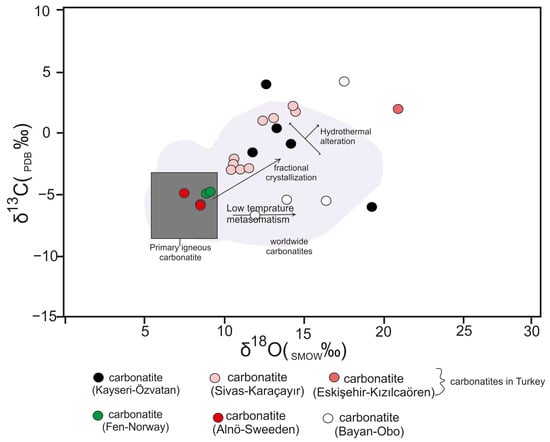
Figure 12.
Carbon and oxygen isotopic compositions for carbonate separates of Özvatan carbonatite samples. The worldwide carbonatite and primary igneous carbonatite data are from Deines [73] and Cimen et al. [74,75]. The isotopic data of primary igneous carbonatite complexes of Fen and Alnö is taken from Andersen [76] and Roopnarain [77], respectively. The isotopic values of Kızılcaören and Karaçayır deposits are from Cimen et al. [9] and Cooper et al. [56].
4.4. Fluid Inclusion Studies
The petrographic analyses and accurate microthermometry were performed on calcite and fluorite crystals containing fluid inclusions (FIs) of appropriate size for the study. Based on the criteria established by Roedder [59] and Van den Kerkof and Hein [78], the primary and secondary FIs were differentiated by having variable shapes: elliptical, elongated, and irregular (Figure 13). At room temperature, the size of the primary and secondary FIs in the calcite minerals ranges from 12–40 µm and from 21–62 µm (some FIs up to 129 µm), respectively (Figure 13a–e). The primary and secondary FIs in the fluorite minerals, on the other hand, vary in size from 21–48 µm (some FIs up to 164 µm), and from 28–31 µm, respectively (Figure 13f–h). All of these FIs are thought to be of the aqueous liquid H2O–vapor (LV) type and to have been homogenized into the liquid phase in the two minerals (Figure 13).
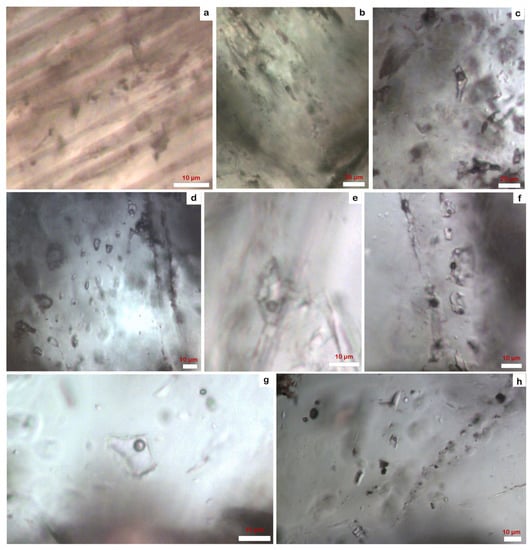
Figure 13.
(a–c) Primary fluid inclusion in calcite mineral; (d,e) secondary fluid inclusion in calcite mineral; (f,g) primary fluid inclusion in fluorite mineral; (h) secondary fluid inclusion in fluorite mineral.
At room temperature, they do not include carbonic phases, but melting of clathrates above 0 °C implies that they should comprise carbonic phases such as carbon dioxide or methane. The eutectic temperatures (Te) of the primary FIs of the calcite minerals were detected around −21.2 °C and around −62.1 °C, suggesting H2O–NaCl as well as H2O–CO2/CH4–NaCl system, respectively (Table 2). While determining Te secondary FIs of calcite minerals, the ranges from −16.9 to −14.6 °C indicate H2O–NaCl system with subordinate carbonic phases due to the final melting temperature (Tm) above 0 °C (Table 2). However, the primary and secondary FIs of fluorite minerals have detected Te of roughly −6.9 °C and −22.7 °C, respectively, also alluding to H2O–NaCl system with subordinate carbonic phases since Tm above 0 °C (Table 2).

Table 2.
Summary of microthermometric data of calcite and fluorite from the study area.
The final ice melting temperatures (Tm-ice) and clathrate melting temperatures (Tm-clathrate) were used to compute the salinities in accordance with the formulae proposed by Darling [79], Archer [80], Bodnar [81], and Steele-MacInnis et al. [82], as well as the BULK computer program of Bakker [83] (Table 3). The average salinities of the FIs (without clathrate) are 6.9 and 2.8 wt. NaCl equivalent for primary and secondary FIs of calcite material, respectively (Table 2), whereas the FIs-bearing clathrate had greater salinities (12.1 and 14.0 wt.% NaCl equivalent for primary and secondary FIs of calcite crystal, respectively) (Table 3). On the other hand, the salinities of the primary FIs of the fluorite mineral including clathrate range from 8.9 to 14.8 wt.% NaCl equivalent (Table 3). Salinities of 9.2 wt.% NaCl equivalent are reported in the secondary FIs of the fluorite mineral that do not include clathrate (Table 3). Using Zhang and Frantz’s [84] equation of state, the total densities of the FIs (those without clathrate) were calculated. They range from 0.82 to 0.99 g/cm−3 (an average of 0.93 g/cm−3) and from 0.77 to 0.98 g/cm−3 (an average of 0.87 g/cm−3) for primary and secondary FIs of calcite minerals (Table 2). However, they vary from 0.90 to 1.03 g/cm−3 with an average of 0.97 g/cm−3 for secondary FIs of fluorite mineral (Table 3). Total homogenization temperature (Th-tot) values for the primary and secondary FIs of calcite minerals are averaged to be 392.3 °C and 290.4 °C, respectively. However, compared to those of calcite, the primary and secondary FIs of the fluorite minerals homogenized at lower temperatures as 119.5 °C and 163.0 °C, respectively (Table 2).

Table 3.
Calculated microthermometric data of calcite and fluorite from the study area.
4.4.1. Composition of Solution Systems
To be economically developed, a rare earth element (REE) resource must be concentrated much above the background levels of all REEs’ percentage concentrations. REE enrichment can indeed take place by either primary processes such as magmatic processes, hydrothermal fluid mobilization, and precipitation, or secondary processes such as sedimentary concentration and weathering that transport REE minerals away from their original formation. As a result, the primary (high-temperature) and secondary (low-temperature) deposit categories can be used to classify natural REE deposits and occurrences [1].
Alkaline–peralkaline igneous rocks and carbonatites generated in extensional intracontinental rifts typically represent the most significant primary deposits often having high grade and tonnage [85]. The formation of the primary REE concentrations can also occur in another variety of different geological environments; consistently related to granites and pegmatites, hydrothermal, and carbothermal systems as well as less frequently in metamorphic or diagenetic environments [85,86,87]. On the other hand, any of these primary enriched varieties may be weathered or eroded to produce secondary deposits such as placers and ion adsorption deposits [86].
The Te of the FIs in the study area is typically about −21.0 °C, with the exception of some primary FIs, which have a Te of −62.1 °C (Table 2). The carbonic phase is not visible at room temperature, but upon freezing of inclusions, the clathrate was created. This indicates that the carbonic phase is present in the solution system. Additionally, the Tm of clathrate ranging from 0.9 to 5.1 °C suggests that the fluids that formed the REE-bearing carbonatite and fluorite deposit might consist of CO2 as the main carbonic phase along with CH4 [78].
4.4.2. Ore-Bearing Fluid Source
To determine the origin of the various ore-bearing fluids, the discriminating diagram taken from Beane [88] between the homogenization temperature versus salinity is utilized (Figure 13). It implies that there is endogenous fluid circulation between the magmatic-meteoric fluid sources in shallow intrusive environments in which the studied FIs fall into the field of magmatic-meteoric mixing (Figure 14). Some of the primary and secondary FIs data from calcite minerals have metamorphic origins (Figure 14), referencing carbonatites that experienced low-grade metamorphism at shallow depth, causing the partial recrystallization of carbonates and apatite with the elimination of some trace elements [88].
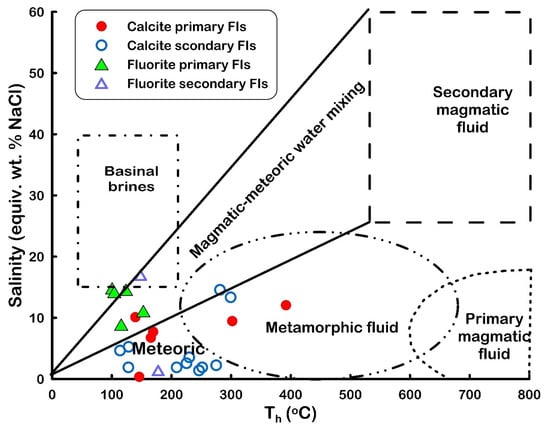
Figure 14.
Salinity vs. homogenization temperature of fluid inclusions in the study area. Base diagram adopted from Beane [88].
5. Discussion
5.1. Evolution of Calciocarbonatites and Silicocarbonatites
The field relationships point out that the calciocarbonatites and silicocarbonatites intruded and fenitised the Özvatan nepheline syenite. The Özvatan carbonatites have low-grade REE (up to 0.27%) ores and are dominated by LREE only. Enrichments of Sr and Nd in carbonatites of the study area indicate the mantle-derived origin of initial melts [89,90]. The emplacement of Özvatan carbonatites occurred in a post-collisional environment [50]; therefore, the fractionation of carbonated melts does not produce fertile carbonatite intrusions such as ferro-carbonatites or magnesio-carbonatites [19,68].
The C and O isotopes of the studied carbonatites represent both fractionations of a carbonated mantle source with low-temperature metasomatic reactions. The relatively high values of δ13C and δ18O values in Özvatan carbonatites, such as the similar Karaçayır carbonatites, indicate a series of events during magma evolution such as crustal contamination, magmatic fractionation, and hydrothermal alteration [37]. Calciocarbonatites of the complex have lighter C (−0.88 to −2.07 ‰) and O (11.7 to 14.1‰) values; however, the low-temperature metasomatism in silicocarbonatites caused higher δ18O values and an increase in overall REE content.
5.2. Fenitization
The presence of carbonatite veinlets in nepheline syenites and secondary subhedral K-feldspars (orthoclasite or feldispatic fenite) around these veinlets (See Figure 3i) can be interpreted as one of the most important pieces of evidence for fenitization [3,19,91]. The fenites around carbonatite dikes and veinlets in the Özvatan complex can be divided into two subgroups:
- (1)
- Sodic fenites in the area are characterized by feldspar and Na-rich aegirine mineralization around carbonatite veins. The sodic fenites in the study area have a mineral assemblage of aegirine-augite, nepheline, and garnet (See Figure 3i–l);
- (2)
- The potassic fenites have abundant K-feldspar (orthoclase) minerals (see Figure 3m–p) and have higher grades of LREE, Th, U, and Nb. The potassic fenites show higher degrees of alteration than sodic fenites and are cut by numerous carbonatite veinlets. Some of the K-fenites are brecciated (See Figure 2h) and have the highest grade of REE (up to 0.36%).
The calciocarbonatites and silicocarbonatites of the Özvatan complex can be considered shallow late-stage carbonatite intrusions due to the transition from magmatic to post-magmatic (hydrothermal) regime [92]. The fluids expelled from the late-stage carbonatite intrusions probably caused the mineralization of REE-bearing minerals [20]. Additionally, these hydrothermal fluids may overprint earlier REE-bearing minerals and elevate overall REE content [62].
In addition, the low-temperature metasomatism observed in fluid inclusion studies caused the remobilization of REE and changed the final compositions of fenitized nepheline syenites [93]. The mineralization of fluorites with low homogenization temperatures can support this conclusion. The rise of Al and Fe along the rims of the K-fenite micas also represents the desilisification reactions that occurred during fenitization [63].
5.3. Fluid Evolution and REE Enrichments
During its evolution, primary fluid may occasionally undergo a change in composition that can be ascribed to boiling, fluid–rock interactions, or contamination by meteoric water. Because of this, fluid inclusions that are trapped either in the liquid or vapor phase should be treated with pressure correction [94].
The pressure correction is not required for inclusions that are trapped at the two-phase boundary (solvi) and exhibit boiling. In these cases, the temperature of homogenization is regarded as the trapping temperature [60,94,95]. Consequently, prior to interpreting microthermometric data, it is essential for fluid inclusions investigation to be aware of fluid-phase equilibria during fluid-phase development.
The investigated samples include coexisting liquid-rich inclusions, which may indicate boiling and surface fluid dilution conditions at the period of entrapment at shallow depths (lower pressure, typically >200 bars) (Figure 15). Mineralization may have resulted from these characteristics, including fluid boiling, surface fluid dilution, cooling, and early magmatic mixing with meteoric fluids [60,96]. Although certain FIs contain higher salinities (up to 16.9 wt.% NaCl equivalent) and Th (up to 392 °C), indicating magmatic origins, they circulated at a lower temperature and mixed with external meteoric water leading to a decrease in the homogeneous temperature and salinity (Figure 15).
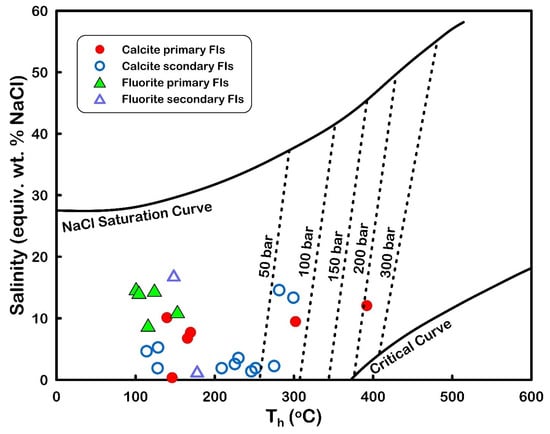
Figure 15.
A plot of salinity vs. homogenization temperature (Th) for a fluid inclusion. NaCl saturation and critical curves are from Ahmad and Rose [97], and lines of NaCl pressure are from Roedder [59].
According to the aforementioned data, the brine-melt develops into a hydrothermal fluid in the late stages of the evolution of carbonatite systems, with the salinity being diluted by an increasing H2O concentration. Depending on the late-stage carbonatite emplacement and the effects of cooling, mixing, and fluid–rock interaction, fluid inclusions and stable isotope data suggest a variety of evolutionary pathways [98]. In contrast to externally produced fluids, which are generally colder (up to 119.5 °C), carbonatite-derived fluids exhibit a temperature of up to 392.3 °C. Furthermore, the low-density inclusions (~0.93 g/cm−3) may emerge from the exsolution, or boiling, of the aqueous and carbonic components from the carbonatite melt (Figure 16).

Figure 16.
A plot of salinity (wt.% NaCl) vs. homogenization temperature (Th °C) for a fluid inclusion reveals tendencies in boiling, isothermal mixing, and necking-down during the fluid’s evolution after Shephard et al. [60] and Wilkinson [96].
The boiling may cause the nearby country rock to fracture, allowing meteoric water to further dilute the carbonatite-derived fluid [98]. It is clear that REEs can be mobilized locally by low-temperature hydrothermal fluids, leading to an additional redistribution of the REEs, when the REE enrichment reaches its peak during the brine-melt stage [93]. Moreover, the dissolution of primary REE-bearing minerals, such as calcite or fluorapatite, can lead to the formation and reprecipitation of rare earth element minerals near the original host [99]. The same fluids that were likely combined with meteoric waters to generate the hydrothermal REE-bearing fluorite resulted in cooling to 119.5 °C and a rise in the chloride component. Due to the fluid’s preferred stability of LREE–chloride complexes and depending on the low-temperature fluid’s composition, the continuous fluid fluxing may lead to fractionation of the light from the heavy REEs [100].
5.4. Fluorite Deposition
Richardson and Holland [101] stated that fluorite can be precipitated from hydrothermal solutions via a broad range of mechanisms, including (1) deposition caused by changes in the temperature and pressure of the ore-bearing fluid; (2) deposition caused by the mixing of two or more fluids with distinct chemical compositions; and (3) deposition caused by ore-forming fluids interacting with wall rocks.
According to fluid inclusion studies, there is endogenous fluid circulation between magmatic-meteoric fluid sources in shallow intrusive environments. In the last stages of the evolution of carbonatite systems, the brine melt transforms into a hydrothermal fluid when the salinity is diluted by rising H2O concentration. Low-density inclusions may form during the exsolution, or boiling, of the carbonatite melt’s aqueous and carbonic components. This fluid, which was most likely mixed with meteoric waters to produce the hydrothermal REE-bearing fluorite, resulted in cooling to 119.5 °C and an increase in the chloride component. This refers to fluorite depositions induced by fluid mixing, in which meteoric water can combine with a concentrated brine at a different temperature (dilution plus cooling). Dilution occurs when hot, concentrated brine flowing up the fracture combines with colder meteoric water. Dilution with cooling of NaCl solutions results in combinations that are undersaturated with regard to fluorite at all ionic strengths [101].
6. Conclusions
This study primarily focuses on the mineralogical, geochemical, fenitization, and fluid inclusion aspects of the Özvatan nepheline syenite–carbonatite complex. The complex generally consists of silica under-saturated ultra-alkaline rocks and coarse-grained carbonatite dikes. Carbonatites in the study area are generally coarse-grained calciocarbonatites (sövites) and silicocarbonatites. These rocks represent significant LREE and LILE enrichments including La, Ce, Nd, Sr, and Ba. The silicocarbonatites are also enriched in Th and U. The carbonatites in the Özvatan complex have quite compatible C and O stable isotope values of Karaçayır carbonatites, which indicate a similar magmatic origin. The isotopic compositions represent the fractionation of metasomatic enriched mantle source with the interference crustal rocks.
The carbonatitic rocks of the Özvatan complex are generally surrounded by metasomatic aureole zones. These metasomatic aureole zones were identified as fenites due to their alteration properties and geochemical compositions. The partial and complete transformation of augites to aegirine minerals also supports the occurrence of progressive fenitization in sodic fenites. The fenite zones are widely identified as K-fenites. The higher intensity zones were brecciated and hosted higher grades of REE, Th, U, and Nb.
In all instances of carbonatite-hosted REE mineralization, dissolution-reprecipitation of REE-bearing minerals occurred on a minor scale, particularly if the dissolution of magmatic calcite occurred. It also reveals that the somewhat high salinity and seemingly higher temperature REE-forming fluids of the carbonatite-hosted mineralization have been changed throughout time by secondary processes in accordance with fluid inclusion data. The high δ18O values indicate the effects of repetitive fenitizing fluids.
Supplementary Materials
The following supporting information can be downloaded at: https://www.mdpi.com/article/10.3390/min13050667/s1, Table S1: the electron microprobe analysis (EPMA) of calcite from carbonatites, Table S2: the electron microprobe analysis (EPMA) of fluorites from fluorite-bearing carbonatites, Table S3: the electron microprobe analysis (EPMA) of micas from K-fenites (in %), Table S4: the major oxide and trace element contents of Özvatan nepheline syenite–carbonatite complex rocks.
Author Contributions
Conceptualization, A.T.U., M.B., Z.D. and A.A.; methodology, A.T.U.; software, A.T.U. and A.A; validation, Z.D.; formal analysis, A.T.U., Z.D. and A.A.; investigation, A.T.U., M.B., Z.D. and A.A.; resources, A.T.U. and M.B; data curation, A.T.U. and A.A.; writing—original draft preparation, A.T.U. and A.A.; writing—review and editing, A.T.U., M.B., Z.D., A.A.; visualization, A.T.U. and A. A; supervision, M.B.; A.T.U. and Z.D. took part in the fieldwork. All authors have read and agreed to the published version of the manuscript.
Funding
This research received no external funding.
Data Availability Statement
Acknowledgments
The authors would like to thank the members of the Geochemistry Research Laboratories of Istanbul Technical University (ITU/JAL) for their effort with geochemical analysis. The authors would also like to thank Huseyin Kocaturk for the electron microprobe analysis. A.A. would like to thank the Ministry of Higher Education of Egypt as well as the Scientific and Technological Research Council of Turkey (2221-TUBITAK Fellowship Program) for supporting his research stay at Istanbul Technical University (Turkey) as a postdoctoral fellow. In addition, thank you Demet Yıldırım and Sercan Öztürk for help during fieldwork. The handling editor and three anonymous reviewers are acknowledged for their insightful comments and suggestions that improved the presentation and interpretations of our work.
Conflicts of Interest
The authors declare no conflict of interest.
References
- Goodenough, K.M.; Schilling, J.; Jonsson, E.; Kalvig, P.; Charles, N.; Tuduri, J.; Deady, E.A.; Sadeghi, M.; Schiellerup, H.; Müller, A.; et al. Europe’s rare earth element resource potential: An overview of REE metallogenetic provinces and their geodynamic setting. Ore Geol. Rev. 2015, 72, 838–856. [Google Scholar] [CrossRef]
- Elliott, H.A.L.; Wall, F.; Chakhmouradian, A.R.; Siegfried, P.R.; Dahlgren, S.; Weatherley, S.; Finch, A.A.; Marks, M.A.W.; Dowman, E.; Deady, E. Fenites associated with carbonatite complexes: A review. Ore Geol. Rev. 2018, 93, 38–59. [Google Scholar] [CrossRef]
- Le Bas, M. Carbonatite Magmas. Mineral. Mag. 1981, 44, 133–140. [Google Scholar] [CrossRef]
- Le Bas, M.J. Nephelinites and carbonatites. Geol. Soc. Lond. Spéc. Publ. 1987, 30, 53–83. [Google Scholar] [CrossRef]
- Wolley, A. The Spatial and Temporal Distribution of Carbonatites. Carbonatites, Genesis and Evolution. In Carbonatites: Genesis and Evolution; Bell, K., Ed.; Unwin Hyman: London, UK, 1989; pp. 15–37. [Google Scholar]
- Millonig, L.J.; Gerdes, A.; Groat, L.A. U–Th–Pb geochronology of meta-carbonatites and meta-alkaline rocks in the southern Canadian Cordillera: A geodynamic perspective. Lithos 2012, 152, 202–217. [Google Scholar] [CrossRef]
- Poletti, J.E.; Cottle, J.M.; Hagen-Peter, G.A.; Lackey, J.S. Petrochronological Constraints on the Origin of the Mountain Pass Ultrapotassic and Carbonatite Intrusive Suite, California. J. Pet. 2016, 57, 1555–1598. [Google Scholar] [CrossRef]
- Mitchell, R.; Chudy, T.; McFarlane, C.R.; Wu, F.-Y. Trace element and isotopic composition of apatite in carbonatites from the Blue River area (British Columbia, Canada) and mineralogy of associated silicate rocks. Lithos 2017, 286–287, 75–91. [Google Scholar] [CrossRef]
- Cimen, O.; Corcoran, L.; Kuebler, C.; SIMONETTI, S.; Simonetti, A. Geochemical, Stable (O, C, and B) and Radiogenic (Sr, Nd, Pb) Isotopic Data from TheEskişehir-Kızılcaören (NW-Anatolia) and the Malatya-Kuluncak (E-Central Anatolia) F-REE-Th Deposits, Turkey: Implications for Nature of Carbonate-Hosted Mineralization. Turk. J. Earth Sci. 2020, 29, 798–814. [Google Scholar] [CrossRef]
- Goodenough, K.M.; Deady, E.A.; Beard, C.D.; Broom-Fendley, S.; Elliott, H.A.L.; Berg, F.v.D.; Öztürk, H. Carbonatites and Alkaline Igneous Rocks in Post-Collisional Settings: Storehouses of Rare Earth Elements. J. Earth Sci. 2021, 32, 1332–1358. [Google Scholar] [CrossRef]
- Kjarsgaard, B.A.; Hamilton, D.L. Liquid immiscibility and the origin of alkali-poor carbonatites. Miner. Mag. 1988, 52, 43–55. [Google Scholar] [CrossRef]
- Brooker, R. The Effect of CO2 Saturation on Immiscibility between Silicate and Carbonate Liquids: An Experimental Study. J. Petrol. 1998, 39, 1905–1915. [Google Scholar] [CrossRef]
- Halama, R.; Vennemann, T.; Siebel, W.; Markl, G. The Gronnedal-Ika Carbonatite-Syenite Complex, South Greenland: Carbonatite Formation by Liquid Immiscibility. J. Petrol. 2004, 46, 191–217. [Google Scholar] [CrossRef]
- Fischer, T.P.; Burnard, P.; Marty, B.; Hilton, D.R.; Füri, E.; Palhol, F.; Sharp, Z.D.; Mangasini, F. Upper-mantle volatile chemistry at Oldoinyo Lengai volcano and the origin of carbonatites. Nature 2009, 459, 77–80. [Google Scholar] [CrossRef] [PubMed]
- Lee, W.-J.; Fanelli, M.; Cava, N.; Wyllie, P. Calciocarbonatite and Magnesiocarbonatite Rocks and Magmas Represented in the System CaO-MgO-CO2-H2O at 0.2 GPa. Mineral. Petrol. 2000, 68, 225–256. [Google Scholar] [CrossRef]
- Lee, W.-J.; Wyllie, P.J. Experimental Data Bearing on Liquid Immiscibility, Crystal Fractionation, and the Origin of Calciocarbonatites and Natrocarbonatites. Int. Geol. Rev. 1994, 36, 797–819. [Google Scholar] [CrossRef]
- Veksler, I.; Nielsen, T.; Sokolov, S. Mineralogy of Crystallized Melt Inclusions from Gardiner and Kovdor Ultramafic Alkaline Complexes: Implications for Carbonatite Genesis. J. Petrol. 1998, 39, 2015–2031. [Google Scholar] [CrossRef]
- Bell, K.; Rukhlov, A. Carbonatites from the Kola Alkaline Province: Origin, Evolution and Source Characteristics. In Phoscorites and Carbonatites from Mantle to Mine: The Key Example of the Kola Alkaline Province; Mineralogical Society Series 10; Mineralogical Society: London, UK, 2004; pp. 421–455. [Google Scholar]
- Le Bas, M.J. Fenites associated with carbonatites. Can. Miner. 2008, 46, 915–932. [Google Scholar] [CrossRef]
- Mariano, A. Nature of Economic Mineralization in Carbonatites and Related Rocks. In Carbonatites: Genesis and Evolution; Bell, K., Ed.; Unwin Hyman: London, UK, 1989; pp. 149–176. [Google Scholar]
- Castor, S.B. The Mountain Pass Rare-Earth Carbonatite and Associated Ultrapotassic Rocks, California. Can. Miner. 2008, 46, 779–806. [Google Scholar] [CrossRef]
- Fan, H.-R.; Yang, K.-F.; Hu, F.-F.; Liu, S.; Wang, K.-Y. The giant Bayan Obo REE-Nb-Fe deposit, China: Controversy and ore genesis. Geosci. Front. 2016, 7, 335–344. [Google Scholar] [CrossRef]
- Jaireth, S.; Hoatson, D.M.; Miezitis, Y. Geological setting and resources of the major rare-earth-element deposits in Australia. Ore Geol. Rev. 2014, 62, 72–128. [Google Scholar] [CrossRef]
- Stumpfl, E.; Kirikoglu, M. Fluorite-Barite-Rare Earths Deposits at Kizilcaören, Turkey. Mitt. Osterr. Geol. Ges. 1985, 78, 193–200. [Google Scholar]
- Morteani, G.; Satir, M. The Bastnaesite-Fluorite-Barite Deposit of the Kizilcaören District, Eskisehir, Turkey. In Lanthanides, Tantalum and Niobium; Springer: Berlin/Heidelberg, Germany, 1989; pp. 189–194. [Google Scholar]
- Nikiforov, A.; Öztürk, H.; Altuncu, S.; Lebedev, V. Kizilcaören Ore-Bearing Complex with Carbonatites (Northwestern Anatolia, Turkey): Formation Time and Mineralogy of Rocks. Geol. Ore Depos. 2014, 56, 35–60. [Google Scholar] [CrossRef]
- Öztürk, H.; Altuncu, S.; Hanilçi, N.; Kasapçı, C.; Goodenough, K.M. Rare Earth Element-Bearing Fluorite Deposits of Turkey: An Overview. Ore Geol. Rev. 2019, 105, 423–444. [Google Scholar] [CrossRef]
- Ozgenc, I.; Kibici, Y. The Geology and Chemical–Mineralogical Properties of Britholite Veins of Basören Village (Kuluncak, Malatya). Geol. Bull. Turk. 1994, 37, 77–85. [Google Scholar]
- Ozgenc, I.; Ilbeyli, N. Geochemical Constraints on Petrogenesis of Late Cretaceous Alkaline Magmatism in East-Central Anatolia (Hasancelebi–Basören, Malatya), Turkey. Mineral. Petrol. 2009, 95, 71–85. [Google Scholar] [CrossRef]
- Dilek, Y.; Altunkaynak, Ş. Geochemistry of Neogene–Quaternary Alkaline Volcanism in Western Anatolia, Turkey, and Implications for the Aegean Mantle. Int. Geol. Rev. 2010, 52, 631–655. [Google Scholar] [CrossRef]
- Budakoglu, M.; Unluer, A.T.; Doner, Z.; Kocaturk, H.; Kaya, M.; Kumral, M.; Kirikoglu, M.S. Constraints on Unconsolidated Pyroclastic Flow Sediments Related REE Enrichments Originated from Potassic-Alkaline Gölcük Stratovolcano: Darıdere-Direkli-Yakaören (DDY) table 4deposits, Southwestern Anatolia of Turkey. Acta Geochim. 2021, 40, 926–944. [Google Scholar] [CrossRef]
- Boztuğ, D. Post-Collisional Central Anatolian Alkaline Plutonism, Turkey. Turk. J. Earth Sci. 1998, 7, 145–166. [Google Scholar]
- Boztuğ, D.; Türksever, E.; Heizler, M.; Jonckheer, R.J.; Tichomirowa, M. 207Pb-206Pb,40Ar-39Ar and Apatite Fission-Track Geothermochronology Revealing the Emplacement, Cooling and Exhumation History of the Karaçayır Syenite (N Sivas), East-Central Anatolia, Turkey. Turk. J. Earth Sci. 2009, 18, 109–125. [Google Scholar]
- Boztuğ, D. SIA-Type Intrusive Associations: Geodynamic Significance of Synchronism between Metamorphism and Magmatism in Central Anatolia, Turkey; Geological Society, Special Publications: London, UK, 2000; Volume 173, pp. 441–458. [Google Scholar]
- Ilbeyli, N.; Pearce, J.; Thirlwall, M.; Mitchell, J. Petrogenesis of collision-related plutonics in Central Anatolia, Turkey. Lithos 2004, 72, 163–182. [Google Scholar] [CrossRef]
- Kadıoğlu, Y.K.; Dilek, Y.; Foland, K.A. Slab break-off and syncollisional origin of the Late Cretaceous magmatism in the Central Anatolian crystalline complex, Turkey. In Postcollisional Tectonics and Magmatism in the Mediterranean Region and Asia; Geological Society of America: Boulder, CO, USA, 2006; Volume 409, p. 381. [Google Scholar] [CrossRef]
- Cimen, O.; Ağrılı, H.; Kuebler, C.; Simonetti, A.; Corcoran, L.; Simonetti, S.; Colak, T.; Inal, S.; Dönmez, C. Geochemical, Isotopic and U-Pb Geochronological Investigation of the Late Cretaceous Karaçayır Carbonatite (Sivas, Turkey): Insights into Mantle Sources within a Post-Collisional Tectonic Setting. Ore Geol. Rev. 2022, 141, 104650. [Google Scholar] [CrossRef]
- Ozkan, H.; Erkan, Y. A Petrological Study on a Foid Syenite Intrusion in Central Anatolia (Kayseri-Turkey). Turk. J. Earth Sci. 1994, 3, 45–55. [Google Scholar]
- Deniz, K. Mica Types as Indication of Magma Nature, Central Anatolia, Turkey. Acta Geol. Sin.-Engl. Ed. 2022, 96, 844–857. [Google Scholar] [CrossRef]
- Fayon, A.K.; Whitney, D.L.; Teyssier, C.; Garver, J.I.; Dilek, Y. Effects of plate convergence obliquity on timing and mechanisms of exhumation of a mid-crustal terrain, the Central Anatolian Crystalline Complex. Earth Planet. Sci. Lett. 2001, 192, 191–205. [Google Scholar] [CrossRef]
- Whitney, D.L.; Teyssier, C.; Dilek, Y.; Fayon, A.K. Metamorphism of the Central Anatolian Crystalline Complex, Turkey: Influence of orogen-normal collision vs. wrench-dominated tectonics on P-T-t paths. J. Metamorph. Geol. 2001, 19, 411–432. [Google Scholar] [CrossRef]
- Şengör, A.; Burke, K.; Dewey, J.F. Tectonics of the North Anatolian Transform Fault. In Multidisciplinary Approach to Earthquake Prediction; Springer: Berlin/Heidelberg, Germany, 1982; pp. 3–22. [Google Scholar]
- Poisson, A.; Guezou, J.C.; Ozturk, A.; Inan, S.; Temiz, H.; Gürsöy, H.; Kavak, K.S.; Özden, S. Tectonic Setting and Evolution of the Sivas Basin, Central Anatolia, Turkey. Int. Geol. Rev. 1996, 38, 838–853. [Google Scholar] [CrossRef]
- Görür, N.; Tuysuz, O. Cretaceous to Miocene Palaeogeographic Evolution of Turkey: Implications for Hydrocarbon Potential. J. Pet. Geol. 2001, 24, 119–146. [Google Scholar] [CrossRef]
- Whitney, D.L.; Teyssier, C.; Fayon, A.K.; Hamilton, M.A.; Heizler, M. Tectonic Controls on Metamorphism, Partial Melting, and Intrusion: Timing and Duration of Regional Metamorphism and Magmatism in the Niğde Massif, Turkey. Tectonophysics 2003, 376, 37–60. [Google Scholar] [CrossRef]
- Whitney, D.L.; Teyssier, C.; Heizler, M.T. Gneiss Domes, Metamorphic Core Complexes, and Wrench Zones: Thermal and Structural Evolution of the Niğde Massif, Central Anatolia. Tectonics 2007, 26, 2040. [Google Scholar] [CrossRef]
- Akiman, O.; Erler, A.; Göncüoǧlu, M.C.; Güleç, N.; Geven, A.; Türeli, T.K.; Kadioǧlu, Y.K. Geochemical Characteristics of Granitoids along the Western Margin of the Central Anatolian Crystalline Complex and Their Tectonic Implications. Geol. J. 1993, 28, 371–382. [Google Scholar] [CrossRef]
- Aydın, N.S.; Göncüoğlu, M.C.; Erler, A. Latest Cretaceous Magmatism in the Central Anatolian Crystalline Complex: Review of Field, Petrographic and Geochemical Features. Turk. J. Earth Sci. 1998, 7, 259–268. [Google Scholar]
- Erler, A.; Akıman, O.; Unan, C.; Dalkılıc, F.; Dalkılıc, B.; Geven, A.; Önen, P. Petrology and Geochemistry of the Magmatic Rocks of the Kırşehir Massif at Kaman (Kırşehir) and Yozgat. Doğa Turk. J. Eng. Environ. Sci. 1991, 15, 76–100. [Google Scholar]
- Koeksal, S.; Göncüoğlu, M.C. Sr and Nd Isotopic Characteristics of Some S-, I-and A-Type Granitoids from Central Anatolia. Turk. J. Earth Sci. 2008, 17, 111–127. [Google Scholar]
- Kraeff, A.; Pasquare, G. Igneous Nepheline-Bearing Rocks of Çukurköy (Northern Part of Province of Kayseri, Turkey). Bull. Miner. Res. Explor. 1966, 66, 124–128. [Google Scholar]
- Erler, A.; Göncüoglu, M.C. Geologic and Tectonic Setting of the Yozgat Batholith, Northern Central Anatolian Crystalline Complex, Turkey. Int. Geol. Rev. 1996, 38, 714–726. [Google Scholar] [CrossRef]
- Aydın, N. Temrezli (Sorgun-Yozgat) Uranyum Yatağının Jeolojisi, Jeokimyası ve Işletilebilirliğinin Incelenmesi. Master’s Thesis, Balıkesir Üniversitesi Fen Bilimleri Enstitüsü, Balıkesir, Turkey, 2016. [Google Scholar]
- Göncüoğlu, M.C. Geochronological Data from the Southern Part (Niğde Area) of the Central Anatolian Massif. Miner. Res. Explor. Inst. Turk. (MTA) Bull. 1986, 105, 111–124. [Google Scholar]
- Boztuğ, D.; Jonckheere, R.C. Apatite fission track data from central Anatolian granitoids (Turkey): Constraints on Neo-Tethyan closure. Tectonics 2007, 26, 1988. [Google Scholar] [CrossRef]
- Cooper, A.F.; Boztuğ, D.; Palin, J.M.; Martin, C.E.; Numata, M. Petrology and petrogenesis of carbonatitic rocks in syenites from central Anatolia, Turkey. Contrib. Miner. Pet. 2010, 161, 811–828. [Google Scholar] [CrossRef]
- Özaksoy, V.; Gökten, E. The Stratigraphy and the Tectonics of Özvatan–Felahiye (Kayseri) Region. Bull. Geol. Soc Turk. 1996, 39, 31–42. [Google Scholar]
- Whitney, D.; Dilek, Y. Core complex development in central Anatolia, Turkey. Geology 1997, 25, 1023–1026. [Google Scholar] [CrossRef]
- Roedder, E. Volume 12: Fluid Inclusions. Rev. Mineral. 1984, 12, 644. [Google Scholar]
- Shepherd, T.; Rankin, A.; Alderton, D. A Practical Guide to Fluid Inclusion Studies; Blackie and Son Ltd.: Glasgow, UK, 1985; 239p. [Google Scholar]
- Tindle, A.G.; Webb, P.C. Estimation of Lithium Contents in Trioctahedral Micas Using Microprobe Data: Application to Micas from Granitic Rocks. Eur. J. Mineral. 1990, 595–610. [Google Scholar] [CrossRef]
- Boomeri, M.; Nakashima, K.; Lentz, D.R. The Miduk Porphyry Cu Deposit, Kerman, Iran: A Geochemical Analysis of the Potassic Zone Including Halogen Element Systematics Related to Cu Mineralization Processes. J. Geochem. Explor. 2009, 103, 17–29. [Google Scholar] [CrossRef]
- Brod, J.; Gaspar, J.; de Araújo, D.; Gibson, S.; Thompson, R.; Junqueira-Brod, T. Phlogopite and tetra-ferriphlogopite from Brazilian carbonatite complexes: Petrogenetic constraints and implications for mineral-chemistry systematics. J. Asian Earth Sci. 2001, 19, 265–296. [Google Scholar] [CrossRef]
- Nachit, H. Composition Chemique Des Biotites et Typologie Magmatique Des Granitoids. Comtes Rendus Hebd. De L’academie Des Sci. 1985, 301, 813–818. [Google Scholar]
- Nachit, H.; Ibhi, A.; Ohoud, M.B. Discrimination between Primary Magmatic Biotites, Reequilibrated Biotites and Neoformed Biotites. Comptes Rendus Geosci. 2005, 337, 1415–1420. [Google Scholar] [CrossRef]
- Middlemost, E.A.K. Naming materials in the magma/igneous rock system. Earth-Sci. Rev. 1994, 37, 215–224. [Google Scholar] [CrossRef]
- Abramov, S.S.; Rass, I.T.; Kononkova, N.N. Fenites of the Miaskite–Carbonatite Complex in the Vishnevye Mountains, Southern Urals, Russia: Origin of the Metasomatic Zoning and Thermodynamic Simulations of the Processes. Petrology 2020, 28, 263–286. [Google Scholar] [CrossRef]
- Höy, T. Geology of the Cottonbelt Lead-Zinc-Magnetite Layer, Carbonatites and Alkalic Rocks in the Mount Grace Area, Frenchman Cap Dome, Southeastern British Columbia; Geological Survey Branch: The District of Vanderhoof, BC, Canada, 1988; Volume 80, ISBN 0-7718-8618-7. [Google Scholar]
- Rosatelli, G.; Humphreys-Williams, E.; Wall, F.; Castorina, F.; Perna, M.; Stoppa, F. The Calatrava paradox to decipher the origin of carbonatites: A petrological insight on Finca La Nava, Calatrava Province (central Spain). Lithos 2022, 416–417, 106649. [Google Scholar] [CrossRef]
- Bas, M.L.; Maitre, R.L.; Streckeisen, A.; Zanettin, B.; IUGS Subcommission on the Systematics of Igneous Rocks. A Chemical Classification of Volcanic Rocks Based on the Total Alkali-Silica Diagram. J. Petrol. 1986, 27, 745–750. [Google Scholar] [CrossRef]
- Boynton, W.V. Cosmochemistry of the Rare Earth Elements: Meteorite Studies. In Developments in Geochemistry; Elsevier: Amsterdam, The Netherlands, 1984; Volume 2, pp. 63–114. ISBN 0921-3198. [Google Scholar]
- Sun, S.S.; McDonough, W.F. Chemical and isotopic systematics of oceanic basalts: Implications for mantle composition and processes. In Magmatism in the Ocean Basin; Geological Society Special Publication: London, UK, 1989; Volume 42, pp. 313–345. [Google Scholar]
- Deines, P. Stable Isotpe Variations in Carbonatites. In Carbonatites: Genesis and Evolution; Bell, K., Ed.; Unwin Hyman: London, UK, 1989; pp. 301–357. [Google Scholar]
- Çimen, O.; Kuebler, C.; Monaco, B.; Simonetti, S.; Corcoran, L.; Chen, W.; Simonetti, A. Boron, carbon, oxygen and radiogenic isotope investigation of carbonatite from the Miaoya complex, central China: Evidences for late-stage REE hydrothermal event and mantle source heterogeneity. Lithos 2018, 322, 225–237. [Google Scholar] [CrossRef]
- Çimen, O.; Kuebler, C.; Simonetti, S.S.; Corcoran, L.; Mitchell, R.; Simonetti, A. Combined boron, radiogenic (Nd, Pb, Sr), stable (C, O) isotopic and geochemical investigations of carbonatites from the Blue River Region, British Columbia (Canada): Implications for mantle sources and recycling of crustal carbon. Chem. Geol. 2019, 529, 119240. [Google Scholar] [CrossRef]
- Andersen, T. Mantle and crustal components in a carbonatite complex, and the evolution of carbonatite magma: Ree and isotopic evidence from the fen complex, southeast Norway. Chem. Geol. Isot. Geosci. Sect. 1987, 65, 147–166. [Google Scholar] [CrossRef]
- Roopnarain, S. Petrogenesis of Carbonatites in the Alnö Complex, Central Sweden. Master’s Thesis, Uppsala University, Uppsala, Sweden, 2013. [Google Scholar]
- Van den Kerkhof, A.M.; Hein, U.F. Fluid inclusion petrography. Lithos 2001, 55, 27–47. [Google Scholar] [CrossRef]
- Darling, R.S. An extended equation to calculate NaCl contents from final clathrate melting temperatures in H2O-CO2-NaCl fluid inclusions: Implications for P-T isochore location. Geochim. Cosmochim. Acta 1991, 55, 3869–3871. [Google Scholar] [CrossRef]
- Archer, D.G. Thermodynamic Properties of the NaBr+ H2O System. J. Phys. Chem. Ref. Data 1991, 20, 509–555. [Google Scholar] [CrossRef]
- Bodnar, R. Revised equation and table for determining the freezing point depression of H2O-Nacl solutions. Geochim. Cosmochim. Acta 1993, 57, 683–684. [Google Scholar] [CrossRef]
- Steele-MacInnis, H.-N. A Microsoft Excel Spreadsheet for Interpreting Microthermometric Data from Fluid Inclusions Based on the PVTX Properties of H2O–NaCl. Comput. Geosci. 2012, 49, 334. [Google Scholar] [CrossRef]
- Bakker, R.J. Package FLUIDS 1. Computer programs for analysis of fluid inclusion data and for modelling bulk fluid properties. Chem. Geol. 2003, 194, 3–23. [Google Scholar] [CrossRef]
- Zhang, Y.-G.; Frantz, J.D. Determination of the homogenization temperatures and densities of supercritical fluids in the system NaClKClCaCl2H2O using synthetic fluid inclusions. Chem. Geol. 1987, 64, 335–350. [Google Scholar] [CrossRef]
- Chakhmouradian, A.R.; Wall, F. Rare Earth Elements: Minerals, Mines, Magnets (and More). Elements 2012, 8, 333–340. [Google Scholar] [CrossRef]
- Wall, F. Rare Earth Elements. In Critical Metals Handbook; Gunn, G., Ed.; John Wiley & Sons: Hoboken, NJ, USA, 2014. [Google Scholar]
- Stoppa, F.; Schiazza, M.; Rosatelli, G.; Castorina, F.; Sharygin, V.V.; Ambrosio, F.A.; Vicentini, N. Italian carbonatite system: From mantle to ore-deposit. Ore Geol. Rev. 2019, 114, 103041. [Google Scholar] [CrossRef]
- Beane, R. The Magmatic-Meteoric Transition. Geotherm. Resour. Counc. Spec. Rep. 1983, 13, 245–253. [Google Scholar]
- Jones, A.P.; Genge, M.; Carmody, L. Carbonate Melts and Carbonatites. Rev. Mineral. Geochem. 2013, 75, 289–322. [Google Scholar] [CrossRef]
- Bell, K.; Simonetti, A. Source of parental melts to carbonatites–critical isotopic constraints. Miner. Pet. 2009, 98, 77–89. [Google Scholar] [CrossRef]
- Sutherland, D.S. Nomenclature of the Potassic-Feldspathic Rocks Associated with Carbonatites. GSA Bull. 1965, 76, 1409. [Google Scholar] [CrossRef]
- Rankin, A.; Linnen, R.; Samson, I. Carbonatite-Associated Rare Metal Deposits: Composition and Evolution of Ore-Forming Fluids—The Fluid Inclusion Evidence. Rare-Elem. Geochem. Miner. Depos. 2005, 17, 299–314. [Google Scholar]
- Broom-Fendley, S.; Heaton, T.; Wall, F.; Gunn, G. Tracing the fluid source of heavy REE mineralisation in carbonatites using a novel method of oxygen-isotope analysis in apatite: The example of Songwe Hill, Malawi. Chem. Geol. 2016, 440, 275–287. [Google Scholar] [CrossRef]
- Roedder, E.; Bodnar, R.J. Geologic Pressure Determinations from Fluid Inclusion Studies. Annu. Rev. Earth Planet. Sci. 1980, 8, 263–301. [Google Scholar] [CrossRef]
- Sirbescu, M.-L.C.; Nabelek, P.I. Crystallization conditions and evolution of magmatic fluids in the Harney Peak Granite and associated pegmatites, Black Hills, South Dakota—Evidence from fluid inclusions. Geochim. Cosmochim. Acta 2003, 67, 2443–2465. [Google Scholar] [CrossRef]
- Wilkinson, J. Fluid inclusions in hydrothermal ore deposits. Lithos 2001, 55, 229–272. [Google Scholar] [CrossRef]
- Ahmad, S.N.; Rose, A.W. Fluid inclusions in porphyry and skarn ore at Santa Rita, New Mexico. Econ. Geol. 1980, 75, 229–250. [Google Scholar] [CrossRef]
- Walter, B.; Giebel, R.J.; Steele-MacInnis, M.; Marks, M.A.; Kolb, J.; Markl, G. Fluid release in carbonatitic systems and its implication for carbonatite magma ascent, compositional evolution and REE-mineralization. In Proceedings of the Goldschmidt Conference 2021, Virtual, 4–9 July 2021. [Google Scholar] [CrossRef]
- Ying, Y.-C.; Chen, W.; Simonetti, A.; Jiang, S.-Y.; Zhao, K.-D. Significance of hydrothermal reworking for REE mineralization associated with carbonatite: Constraints from in situ trace element and C-Sr isotope study of calcite and apatite from the Miaoya carbonatite complex (China). Geochim. Cosmochim. Acta 2020, 280, 340–359. [Google Scholar] [CrossRef]
- Migdisov, A.; Williams-Jones, A.; Brugger, J.; Caporuscio, F. Hydrothermal transport, deposition, and fractionation of the REE: Experimental data and thermodynamic calculations. Chem. Geol. 2016, 439, 13–42. [Google Scholar] [CrossRef]
- Richardson, C.K.; Holland, H. Fluorite Deposition in Hydrothermal Systems. Geochim. Cosmochim. Acta 1979, 43, 1327–1335. [Google Scholar] [CrossRef]
Disclaimer/Publisher’s Note: The statements, opinions and data contained in all publications are solely those of the individual author(s) and contributor(s) and not of MDPI and/or the editor(s). MDPI and/or the editor(s) disclaim responsibility for any injury to people or property resulting from any ideas, methods, instructions or products referred to in the content. |
© 2023 by the authors. Licensee MDPI, Basel, Switzerland. This article is an open access article distributed under the terms and conditions of the Creative Commons Attribution (CC BY) license (https://creativecommons.org/licenses/by/4.0/).